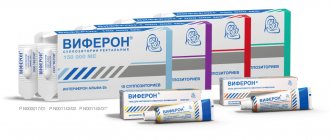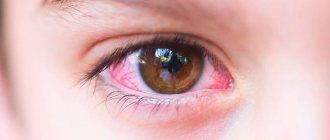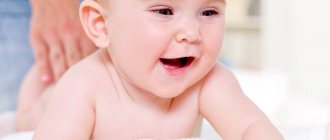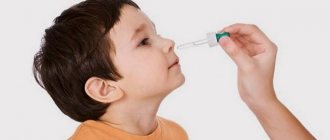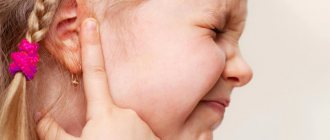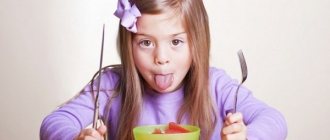Children suffer from food poisoning more often than adults. To protect a child from poisoning, it is necessary to follow the rules for preparing, storing and eating food, and also know how to act in an emergency.
Food poisoning is an acute condition caused by consuming food or water contaminated with bacteria and toxins or other substances. Children under 5 years of age are more at risk of food poisoning. This is due both to an incompletely formed immune system, which is not able to effectively suppress pathogens, and to the reduced acidity of gastric juice in children, which increases the likelihood of dangerous substances entering the intestines and bloodstream.
Food poisoning is more dangerous for children than for adults. It often causes vomiting and diarrhea at the same time, leading to rapid dehydration. Due to the small supply of fluid in the child's body, it is important to constantly monitor the amount of water consumed by the child. If the poisoning is caused by E. coli, the risk of developing a dangerous complication increases: hemolytic-uremic syndrome, which is one of the common causes of acute renal failure in children. Therefore, at the first suspicion of poisoning in a baby, it is necessary to seek qualified medical help as soon as possible.
Symptoms of food poisoning
Signs of poisoning depend on what pathogen has entered the child’s body. Typically, the disease develops as follows: the pathogen enters the gastrointestinal tract along with poor-quality food, bacteria begin to actively develop, releasing waste products into the intestines. As a result, acute intoxication develops and the first symptoms appear:
- painful abdominal cramps, which may be accompanied by bloating and increased gas production;
- frequent loose stools. Foreign inclusions may be observed in the stool - a large amount of mucus, blood, stool may be greenish, foamy;
- nausea and vomiting.
At the same time, the temperature rises to 38-38.5℃. Children become lethargic, capricious, and refuse to eat. Newborns may cry loudly non-stop and pull their legs towards their tummy. Often food poisoning in children is accompanied by symptoms from the nervous system: headache.
Other signs and speed of development of the disease depend on what pathogen has entered the child’s body:
- Staphylococcus aureus. The bacterium develops in cooked food if storage conditions are not met. May be found in prepared meats, baked goods, and sandwiches. Poisoning manifests itself within 30-60 minutes after eating low-quality food, cramping abdominal pain, diarrhea and vomiting appear;
- clostridia. The pathogen is most often found in beef and pork, especially in large hams, when it is not possible to completely cook the core. The infection is characterized by a sudden onset: diarrhea and minor abdominal pain appear, without nausea or fever;
- norovirus. It lives on green leaves, fresh fruits, and can be found in raw shellfish. The first signs appear after a day. The child begins to complain of loose, painful stools, frequent urge to defecate, and severe nausea;
- salmonella. Found in unprocessed milk, eggs, and chicken. Infection causes high fever up to 38.5℃, diarrhea, vomiting, accompanied by severe cramping abdominal cramps;
- coli. It lives in unpasteurized milk and juice, and is found in beef meat. The main difference between poisoning is the appearance of blood impurities in the stool. There is a high probability of developing renal failure;
- botulinum toxin. It is found in improperly prepared pickles and marinades. If botulism develops, the functioning of not only the gastrointestinal tract, but also the nervous system is disrupted: the patient complains of blurred vision, it is difficult for him to control his limbs and turn his head.
Any malaise and a child’s complaints of pain in the abdomen are an alarming symptom. It is recommended to call an ambulance immediately.
Types of poisoning in children
Doctors classify types of intoxications based on the cause of their occurrence. This directly affects the tactics and treatment regimen.
Food
The most common group of poisonings, not only for children, but also for adults. Preparing dishes from not fresh, contaminated or low-quality products, or long-term storage of prepared food in the refrigerator can lead to a hospital bed. For young children, food that is not suitable for their age often becomes a source of intoxication.
Botanical
They are associated with the consumption of poisonous “gifts of nature.”
- Children are very tempted to put a bright berry or a beautiful flower into their mouth.
- Older children do not always distinguish between edible and inedible, confusing, for example, decorative beans with table beans.
- Some indoor plants are also dangerous. For example, one leaf of Dieffenbachia can poison not only a child, but also a strong adult man.
- And, of course, any mushrooms are prohibited: even if they are not poisonous, their structure, like a sponge, accumulates toxins from the soil, air, and water.
Medication
Poisoning can be caused not only by accidental intake of medications, but also by violation of their dosage, as well as a combination of incompatible drugs. Here parents are required to be pedantic and scrupulous - read the instructions carefully and follow them.
Inhalation
Inhalation of toxic fumes and gases is extremely dangerous: it affects the respiratory center, affects red blood cells, disrupts oxygen absorption and affects the brain.
Poisoning can be caused by:
- carbon monoxide and household monoxide;
- varnishes, paints;
- acetone;
- glue;
- petrol;
- ammonia, etc.
Chemical
Household chemical acids, plumbing cleaners, cosmetics, solvents, etc., once in a child’s body, affect the gastrointestinal tract.
First aid for poisoning
The first thing to do if you suspect a child has food poisoning is to call an ambulance or a doctor at home. While you wait for the doctor to arrive, give your child more fluids to prevent dehydration. Children under one year old can be given a teaspoon of water every 5-7 minutes.
You should not self-medicate or give your child any medications without consulting a doctor. If the baby’s condition is serious, then when calling an ambulance, ask what you should do and strictly follow the instructions received.
If the child is shivering, cover him with a warm blanket and ensure complete rest. In case of food poisoning, gastric lavage may be required. But if you are not sure that this is what causes the disease, do not take any action on your own. Remember that vomiting, fever and severe abdominal pain do not always indicate poisoning. Similar symptoms are accompanied by other diseases, such as appendicitis.
In what cases should you consult a doctor?
Self-medication is not always a good idea; in some cases it is still better to seek help from a specialist:
- if poisoning occurs in a newborn, then you must call a doctor, since at this time he should always be under the supervision of an experienced medical professional. personnel;
- poisoning occurred due to the consumption of mushrooms, or poisonous berries, as well as chemicals;
- vomiting in case of poisoning continues for several hours;
- a certain amount of blood was found in the vomit or stool;
- the state of health after poisoning does not improve either the next day or the day after;
- Symptoms of poisoning such as nausea and diarrhea also do not go away for more than three days.
Prevention
In order to avoid food poisoning in children, parents just need to follow simple rules:
- Handle food correctly, do not leave meat or fish undercooked or undercooked.
- Always check the expiration dates of products given to your child, and also follow the rules for storing them.
- Teach from childhood which berries you can eat and which you can’t. It will be better if he first brings them for inspection. If there are doubts about the quality and type of mushrooms, then children should not be given them at all.
- Accustom your child to personal hygiene.
The health of children directly depends on the attitude of their parents and how responsibly they approach what they eat. And also, if the rules of cleanliness are instilled in children from an early age and their horizons about plants are broadened, then they themselves will also be able to avoid an unpleasant situation.
When to seek medical help?
The younger the child, the more dangerous food poisoning can be for him. Therefore, you should immediately contact an ambulance if your baby experiences:
- loss of interest in food;
- vomit;
- incessant crying;
- diarrhea;
- temperature.
The baby may begin to cry loudly non-stop or pull his legs towards his stomach due to spasms in the gastrointestinal tract. Before the ambulance arrives, make sure that the baby is receiving enough fluids.
In older children, symptoms of poisoning may be less obvious. You should consult a doctor as soon as possible if:
- diarrhea does not stop for more than 3 days;
- more than 4 episodes of vomiting occurred per day;
- there is blood in the stool;
- temperature rises above 38℃;
- the child experiences severe abdominal pain.
Other dangerous symptoms include: confusion, lethargy, headache, rapid heartbeat, weakened pulse. Pay attention to how often the child urinates - the absence of urine for 5-6 hours may indicate dehydration.
The use of enemas for food poisoning
Sometimes, it becomes necessary to rinse not only the stomach, but also the intestines in order to get rid of the toxins located there. To do this, you can resort to an enema.
The essence of an enema is that a special solution is injected into the intestines using a special device. This solution lingers in the body for a short time, and then, leaving it, washes away all the decay products inside. In order to give an enema to children, you need to seek the help of a person experienced in these matters, as damage can be caused.
To properly administer an enema, you need to follow a certain algorithm:
- A rubber bulb of suitable size (check with the pharmacy) must be boiled in clean water for half an hour for disinfection.
- Hands should be washed thoroughly; you can wear medical gloves.
- The child is placed in the correct position, if it is a newborn, then on his back, having first placed a diaper or diaper under him. If we are talking about an adult child, then he should lie on his side, pulling his legs to his chest.
- You need to fill the pear with warm, clean water or a prepared solution.
- The enema tip must be lubricated with special Vaseline.
- Having pulled the baby's legs towards the stomach, you need to carefully insert the tip into the anus 3-4 cm. First, you need to release the air from the bulb by pressing on it. As for adult children, the procedure is carried out in the same way, only they bent their legs on their own.
- The contents of the enema should be administered while the child inhales, slowly pressing it.
It is necessary for the child to be patient and then go to the toilet or potty. If we are talking about a baby, then you need to squeeze the buttocks so that the liquid does not come out immediately, since he does not yet know how to endure it on his own.
If the emptying went well, the procedure is repeated. After this, the child is washed and dressed in clean linen.
Diet for child poisoning
Treatment for food poisoning is selected by a gastroenterologist. Enterosorbents may be prescribed to remove toxins from the gastrointestinal tract, antimicrobial or antiviral agents. When treating the disease, much attention is paid to diet.
For newborns, the following feeding schedule should be followed:
- when breastfeeding: until the condition normalizes, you must stop feeding the baby milk, you must give a large amount of boiled warm water. As soon as the vomiting and diarrhea stop, you can return to your usual feeding pattern (unless your doctor says otherwise);
- with artificial feeding: in agreement with the doctor, stop feeding for 8-12 hours, give a large amount of warm water. Then you can gradually return fermented milk mixtures and rice water to your diet. Give other products (for example, vegetable and fruit purees, ground meat) a few days after stool normalization. As a rule, detailed recommendations are made by the attending pediatrician.
For older children, the diet is different. Usually, until the nausea and vomiting stops, the child himself refuses to eat. This is normal, but you need to make sure he drinks enough. If a child's lips are dry, this indicates dehydration.
As soon as the child's appetite returns, he can be given:
- rice porridge with water;
- mashed potatoes in water without oil;
- crackers;
- vegetarian puree soups.
Food must be consumed in small portions at short intervals. This way you reduce the burden on the gastrointestinal tract and protect the child from the recurrence of nausea or diarrhea.
You can return to your usual diet as directed by your doctor. But even after recovery for 2-4 weeks, it is better to stick to a diet: avoid salty and smoked foods, baked goods, and carbonated drinks.
First aid
What to do if a child is poisoned at home, immediately after it is detected:
- First, you need to provide constant drinking in order to avoid dehydration in case of poisoning. This should be clean, boiled water at room temperature. Children over 5 years old can be given decoctions of chamomile, rose hips or tea.
- Next, you need to give sorbents, this can be activated carbon, which absorbs harmful substances and calmly removes them from the body. However, taking sorbents is prohibited if there is gastric bleeding or intestinal obstruction.
- It is also necessary to carefully monitor your diet during this period. On the first day, it is better to refrain from eating. The next day, you can start giving crackers, porridge with water, light broths, teas, medicinal decoctions or plain water. It is better to stick to this diet for several days, carefully returning to the previous one, excluding, accordingly, foods that can cause poisoning.
It should be remembered that during the treatment of poisoning, it is better not to resort to those medications and products that can harden the stool. It is better if all harmful substances leave the body naturally, because this is why the protective function in the form of diarrhea or nausea is activated.
Medicines to treat food poisoning in children
To speed up the treatment process for food poisoning in children, you can take special medications.
Medicines
Currently, many medications have been created aimed at getting rid of the symptoms of poisoning, as well as restoring the body, which are also suitable for children, for example:
- Regidron - suitable for getting rid of diarrhea and vomiting, it is available in the form of a powder, which must be diluted in warm, clean water and given to the child with this solution throughout the day.
- Smecta is also available in powder form, which must be drunk several times a day for 3–7 days, depending on the severity of the poisoning.
- Lactofiltrum - available in tablets, restores intestinal health.
The main thing to remember is that any medicine has its contraindications for use and age restrictions, so before use you must carefully read the instructions, which also indicate the method of use and dosage.
Sorbents
Sorbents are medicines that are taken during the provision of surgical assistance, before the arrival of doctors or before the provision of basic treatment. They are able to absorb all harmful bacteria and remove them from the body.
Activated carbon is considered the most common and accessible sorbent. His tablet is capable of absorbing all toxins, subsequently increasing in size. The amount of activated carbon taken is always calculated as follows: 1 kg of the patient’s weight * 1 tablet. Read more about sorbents in the article: TOP 5 sorbents for children.
In addition to coal, there are a number of other sorbents, for example, Enterosgel - paste for oral administration, Sorbex, Atoxil. The main thing when purchasing medications is to also pay attention to the expiration date of the drug.
Probiotics
Probiotics are drugs that contain one or more beneficial bacteria, which, after entering the body, remain in it and begin to conduct useful life activities, fighting harmful organisms.
Probiotics include drugs such as acylact, lactobacterin, biobacton, probifor.
Antibiotics
Taking antibiotics when treating food poisoning in a child at home is excluded. Such medications can only be prescribed by the attending physician if the disease has reached a serious stage of complications, and after weighing the pros and cons, it was decided that the harm caused to the child’s body will be lower than the developing complications.
Drugs are prescribed based on the individual characteristics of the patient, this can be: ersefuril, phthalazole, cefix.
Prevention of food poisoning
To prevent food poisoning, give your child only clean and properly processed food. There are four steps to ensuring your food is free of pathogens:
- thorough cleaning. Before preparing food, you must wash your hands, kitchen utensils, fresh vegetables and fruits under running water using special products;
- protection against cross contamination. Raw foods should not be allowed to come into contact with cooked foods: eggs, raw meat, poultry and fish should be stored in separate containers and cut on separate cutting boards. This will prevent bacteria from getting from raw food into prepared dishes;
- heat treatment. Most bacteria and viruses are killed when heated above 100℃;
- quick freezing. If you store frozen food, make sure the freezer compartment is kept at a low enough temperature and remember to wipe it down periodically.
By using these rules, you guarantee that your child will not be poisoned by homemade food. But this is not enough: he can catch an intestinal infection outside the home. Therefore, it is necessary to teach children to observe the rules of personal hygiene from an early age. Explain to your child that it is necessary to wash your hands before eating; you cannot eat vegetables and fruits without washing them.
Also, resistance to food poisoning is higher if the child has a strong immune system. To strengthen children's immunity it is recommended:
- lead an active lifestyle - do gymnastics with your child, enroll him in a sports section;
- take regular walks – if it’s cold outside, make sure to wear clothes that are appropriate for the season;
- develop a daily routine - it is especially useful for preschool children. Adequate sleep and eating at the same time allow the child’s body to better cope with stress and resist infectious agents;
- balance your diet. Dysbacteriosis further weakens the immune system and increases the risk of food poisoning.
In the warm season, you should not prepare food for future use - pathogenic microflora quickly develops in it. Under 5 years of age, you should not include dishes with mushrooms, pickled and salty foods in your child’s diet. There is a high probability that the baby’s body will not cope with them and poisoning will develop. If you buy finished products (for example, baked goods), make sure that the manufacturer has all the necessary sanitary permits. It is better not to give street food to children. Detailed recommendations on feeding children can be obtained during a consultation with a pediatrician or pediatric gastroenterologist.
0
1
3
Article rating:
4.44 out of 5 based on 9 ratings
Author: Mikusko-Petrova Olga Zosimovna
Pediatric gastroenterologist. Highest category. Work experience 13 years.
Prevention
Everything is very simple here - to prevent poisoning in children, you just need to remember the simple rules:
- Wash your hands after going to the toilet, after going outside and before eating (soap should contact the skin for at least 30 seconds).
- Keep dishes and kitchen utensils clean, thoroughly clean and wash fruits and vegetables.
- Follow the rules of heat treatment and storage of products.
- Do not eat food that smells suspicious or tastes sour or rotten. It's better to play it safe and cook something fresh.
By following these rules, you will not only avoid food poisoning in the family, but also instill a culture of healthy eating and proper behavior in your children.

